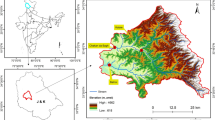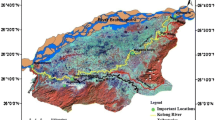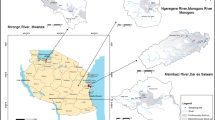Abstract
Design, operation and management of dams and reservoirs is governed by the discharge and sediment load and of a river. Despite being among the largest river basins in the world, sediment–discharge ratings of the Ganga River has received little attention from the researchers probably due to lack of data availability. The present paper aims at analysing the sediment and discharge rating characteristics at 15 gauging stations of the Ganga River. Significant scatter exists in the sediment–discharge relationship during monsoon season and as such a single rating curve was not found adequate to define the sediment–discharge relationship. To address the scatter in sediment–discharge relationship, a novel monthly index number was introduced in sediment–discharge rating curve equation. The rating equation parameters were estimated using a generalized reduced gradient (GRG) solver available in MATLAB. Qualitative as well as quantitative comparison of single rating curves with monthly sediment rating curves reveal that monthly sediment rating curves were in better agreement with the observed data as compared to the single rating curve. Significant spatiotemporal variation in sediment and discharge and inverse correlation between sediment rating parameters exist in the Ganga River. It was also observed that the scatter in stage–discharge relationship was less as compared to the sediment–discharge relationship. No consistent relationship could be found between rating curve parameters and the magnitude of discharge or season. The concept of index number can be applied to other rivers where significant monthly or seasonal scatter in sediment–discharge relationship exist.










Similar content being viewed by others
References
Abbas N, Subramanian V (1984) Erosion and sediment transport in the Ganges River basin (India). J Hydrol 69(1-4):173–182
Asselman NEM (2000) Fitting and interpretation of sediment rating curves. J Hydrol 234:228–248
Barati R (2013) Application of Excel solver for parameter estimation of the nonlinear Muskingum models. KSCE J Civ Eng 17(5):1139–1148
Barati R, Neyshabouri SAAS, Ahmadi G (2018) Issues in Eulerian–Lagrangian modeling of sediment transport under saltation regime. International Journal of Sediment Research 33(4):441–461
Bussi G, Dadson SJ, Bowes MJ, Whitehead PG (2017) Seasonal and interannual changes in sediment transport identified through sediment rating curves. J Hydrol Eng 22(2):06016016
Crowder DW, Demissie M & Markus M (2007). The accuracy of sediment loads when log-transformation produces nonlinear sediment load–discharge relationships. 250–268. doi:https://doi.org/10.1016/j.jhydrol.2006.12.024, 336, 250, 268.
Efthimiou N (2019) The role of sediment rating curve development methodology on river load modeling. Environ Monit Assess 191(2):108
Ghadim HB, Salarijazi M, Ahmadianfar I, Heydari M, Zhang T (2020) Developing a sediment rating curve model using the curve slope. Pol J Environ Stud 29(2)
Harrington ST, Harrington JR (2013) An assessment of the suspended sediment rating curve approach for load estimation on the rivers Bandon and Owenabue. Ireland Geomor 185:27–38
Hasnain SI (1996) Factors controlling suspended sediment transport in Himalayan glacier meltwaters. J Hydrol 181(1-4):49–62
Higgins A, Restrepo JC, Ortiz JC, Pierini J, Otero L (2016) Suspended sediment transport in the Magdalena River (Colombia, South America): hydrologic regime, rating parameters and effective discharge variability. Inter J Sed Resear 31(1):25–35
Hirsch RM (2014) Large biases in regression-based constituent flux estimates: causes and diagnostic tools. JAWRA Journal of the American Water Resources Association 50(6):1401–1424
Jain SK (2008) Development of integrated discharge and sediment rating relation using a compound neural network. J Hydrol Eng 13(3):124–131
Jurotich M, Cardona N, Vázquez B, Wetzel R, Cowman T, Sweeney M (2021) Contributions of suspended load from Missouri River tributaries, southeast South Dakota, and northeast Nebraska: building a sediment budget. River Research and. https://doi.org/10.1002/rra.3767
Khaleghi MR, Varvani J (2018) Sediment rating curve parameters relationship with watershed characteristics in the semiarid river watersheds. Arab J Sci Eng 43(7):3725–3737
Kisi O (2004) Multi-layer perceptrons with Levenberg-Marquardt training algorithm for suspended sediment concentration prediction and estimation. Hydrol Sci J 49(6):1025–1040
Kisi O (2012) Modeling discharge-suspended sediment relationship using least square support vector machine. J Hydrol 456:110–120
Kumar ARS, Ojha CSP, Goyal MK, Singh RD, Swamee PK (2012) Modelling of suspended sediment concentration at Kasol in India using ANN, fuzzy logic, and decision tree algorithms. J Hydrol Eng 394–404:394–404. https://doi.org/10.1061/(ASCE)HE.1943-5584.0000445
Li Z, Xu X, Xu C, Liu M, Wang K, Yi R (2017) Monthly sediment discharge changes and estimates in a typical karst catchment of southwest China. J Hydrol 555:95–107
Lohani AK, Goel NK, Bhatia KKS (2007) Deriving stage-discharge-sediment concentration relationships using Fuzzy logic. Hydrol Sci J 52(4):793–807
Ma Y, Hung HG, Xu J, Brierley GJ, Yao Z (2010) Variability of effective discharge for suspended sediment transport in a large semi-arid river basin. J Hydrol 388:357–369
Mimikou M (1982) An investigation of suspended sediment rating curves in western and northern Greece. Hydrol Sci J 27(3):369–383
Morgan RPC (1995) Soil erosion and conservation, second edn. Longman, London
Muzzammil M, Alam J, Zakwan M (2015) An optimization technique for estimation of rating curve parameters. Nat Symp Hydrol:234–240
Nagy HM, Watanabe K, Hirano M (2002) Prediction of sediment load concentration in rivers using artificial neural networks. J Hydrol Eng 128(6):588–595
Nash DB (1994) Effective sediment-transporting discharge from magnitude–frequency analysis. J Geol 102:79–95
Niazkar M, Zakwan M (2021) Assessment of artificial intelligence models for developing single-value and loop rating curves. Complexity 2021:1–21
Peters-Kümmerly BE (1973) Untersuchungen über zusammensetzung und transport von schwebstoffen in einigen schweizer flüssen. Geographica Helvetica 28(3):137–151
Rezaei K, Pradhan B, Vadiati M, Nadiri AA (2021) Suspended sediment load prediction using artificial intelligence techniques: comparison between four state-of-the-art artificial neural network techniques. Arab J Geosci 14(3):1–13
Tachi SE, Bouguerra H, Derdous O, Djabri L, Benmamar S (2020) Estimating suspended sediment concentration at different time scales in Northeastern Algeria. Appl Water Sci 10(5):1–8
Yang CC, Lee KT (2018) Analysis of flow-sediment rating curve hysteresis based on flow and sediment travel time estimations. International Journal of Sediment Research 33(2):171–182
Yang G, Chen Z, Yu F, Wang Z, Zhao Y, Wang Z (2007) Sediment rating parameters and their implications: Yangtze River, China. Geomor 85(3):166–175
Zakwan M (2018) Spreadsheet-based modelling of hysteresis-affected curves. Appl Water Sci 8(4):101
Zakwan M, Ahmad Z (2021) Trend analysis of hydrological parameters of Ganga River. Arab J Geosci 14(3):1–15
Zakwan M, Muzzammil M, Alam J (2017) Developing stage-discharge relations using optimization techniques. Aquademia: Water, Environment and Technology 1(2):05
Zakwan M, Ahmad Z, Sharief SMV (2018) Magnitude-frequency analysis for suspended sediment transport in the Ganga River. J Hydrol Eng 23(7):05018013
Zhang Q, Harman CJ, & Ball WP (2016). An improved method for interpretation of concentration-discharge relationships in riverine water-quality data. In AGU Fall Meeting Abstracts
Zhang S, Chen D, Li F, He L, Yan M, Yan Y (2018) Evaluating spatial variation of suspended sediment rating curves in the middle Yellow River basin, China. Hydrol Process 32(11):1616–1624
Acknowledgements
The authors are thankful to Central Water Commission (CWC), India, for providing data and the Ministry of Water Resource (MoWR), India, for the funding.
Author information
Authors and Affiliations
Corresponding author
Additional information
Responsible Editor: Broder J. Merkel
Rights and permissions
About this article
Cite this article
Zakwan, ., Ahmad, Z. Analysis of sediment and discharge ratings of Ganga River, India. Arab J Geosci 14, 2026 (2021). https://doi.org/10.1007/s12517-021-08397-1
Received:
Accepted:
Published:
DOI: https://doi.org/10.1007/s12517-021-08397-1




